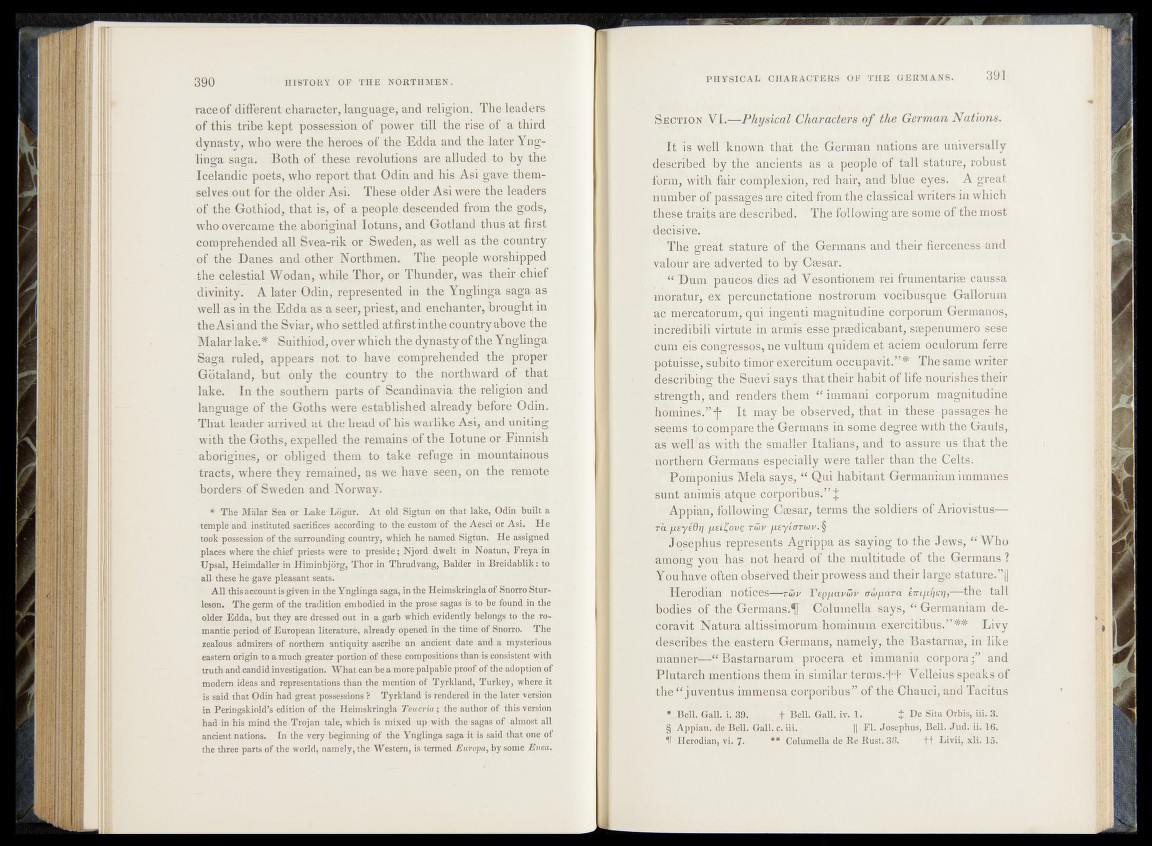
race of different character, language, and religion. The lead ers
of this tribè kept possession of power till the riéeöf a third
dynasty, who were the heroes of the =Edda and the later Yng- _
linga saga. Both off these revol.ntioris are alluded'-to by the
Icelandic poets, who report, that Odin and, his Asi gave thetn-
selves.out for the older Asi. These older Asi were the leaders
of the Grothiod, that is, of a people descended -from the gpd%
who overcame the aboriginal lotuias, and Gotland thus at first
comprehended all Svea-rik or Sweden, as 'well as the ^pantry,
of the Banes and other Northmen* The people,worshipped
the celestial Wodan, while/Thor, or Thunder, wap their, chief
divinity. A later Odin, represented in the'Ynglinga saga as
well as in the Edda as a seer, priest, and enchanter, brought in
the Asiand the Sviar, who settled at first in the epjijntry afeovfe the
Malar Iake.f Suithiod, over which the dynastypf the Ynglipga
Saga ruled, appears not to have comprehpnjded^ithe f^pjoper
Gotaland, but only the country to the nnrthward -©£-■-that
lake. In the southern parts of ^candinavia ^the^iligion'aöd.
language of the Goths werp established already l^ ^ r e ;^ d in .
That leader anivedjat the head of hip ^warlike Asi,, and.uniting
with the Goths, expelled the remainsiof the Iptjjne ;ar^ E^niu-Jj
aborigines, or oblitód them to take refuge, ija- ^§|iBitainoi^|_.
tracts, where they remained, as we have, seen, ,-on the remote
borders of Sweden and Norway. -
* The -Malar Sea or Lake Lögur. At old Sigtun on th a t lake, Odin built a
temple and instituted sacrifices according to the custom'df, the Aesci o&Asi. He
took possession of the surrounding country, which he named Sigfdn. He assigned
places where the duef priests were to presideNjord dwelt in Noatun, Freya ih
Upsal, Heimdalkr in Hhninhjorg, Thor in T h riv in g , Balder in JBreidahlik: to
all these he gate pleasant seats.
All this aceount is given in the Ynglinga saga, in the Heimskringla of Snorro Stur-
leson. The germ of the tradition embodied in the, prose sagas is to he foj^pd.ip the
^older Edda, hut they are dressed out in a garb which evidently belongs to the romantic
period of European literature, already opened in 'thé time of'Shorro. The
zealous admirers- of northern antiqdity ascribe an ancient date and a mysterious
eastern origin to a much greater portion of these compositions than is consistent with
truth and candid investigation. What can he a more-palpable proof pfjthe adoption of
modem ideas and. representations than the mention of f yrkland, Turkey, where it
is said that Odin had great possessions ? Tyrkland is rendered iff the later version
in Peringskiold’s edition of the Heimskringla T e u c r ia ; the author of this version
had in his mind the Trojan tale, which is mixed up with the sagas of almost all
ancient nations. In the very-beginning of the Ynglinga saga ff fs said that one of
the three parts of the world, namely, the Western, is termed E u ro p a , by some E n e a .
S^'yio.N vYI^r—Physical Characters o f the German Nations.
It is well known that the German nations are universally
•(Scribed by lne” a|iciehts as a people of tall stature, robust
form, with fairicolmplexibh, ‘red hair, and blue eyes. A great
number of passages are cite9*fPbm the classical writers in which
tHese^tfait's'are dilcribed. The"following are some of the most
pde'cisive.- s-<
The great sl’ature'ol the'Germans and their ffefcenessmnd
valour ar&adverted t6”b,y*Cmkar.’
“ Dum‘'pau^'s;GTCS ad Vesontibnem rei frumentariee caussa
mo'ratur, ex’percufr ctatiorfe'nuitroram vocibusque Gallorum
’m^mbfcktbrum; qui in'gehtr magnitudine corporum Germanos,
S |red ib ili virtute‘|ri armi^iel|e^faedicabant,;^!penumero sese
cufn^^rcqngr^s^pj ndvdltuffi qu^^m e t aciem oculorum ferre
-potuisse, s,ubkp,'£in^ i^rpitui^o^ptipavit.,’#' The same writer
deMriuln^;the5pulyi^ays that their nabit of life nouri^bfes their
and renders Itiem' “ immani corpqrum magnitudine
IWpineV’i* It mAy® observdd^that in thbs'e passages he
's^ecihs tp compare the Germans in sonltfe-degree with the'Gauls,.
ds^weH^s with the smaller Italians, and £p ggsure us that the
northern Germans fl||e|nally were taller'than the Celts.
v Po™pomij| Mela-sayS1, “ Qui habitant Germaniam immanes
llunt animisatqi^^Wjporibas/'fL*'4
^A ^ p ian , followingjG^sari terms the soldiers of Ariovistus—
TaffiiyiBri jjish^ivQ Tuiv fj.iyiffTU)v.§
^j-osephus represents Agrippa as saying to the Jews, “ Who
among ypu haj£ not heard of fhe multitude of the Germans ?
You have often obsefvpd their prowess and their large stature.”||
^"'rlerodian notices—r&v pJtpuavSjv owfidTpe ETr^pijK^y^-tteB^ tall,
bodies*of fheijermahs:^[ Gofumella ta ^ i, “ Germaniam dh-
dh’ravit j^atura altissimorum hominuin exercitihus.’’## Livy
describes the^feastern Germans, namely, the Bastarnae, in like
manner—-“ Bastarnarum ’ pfocera et immani a corpora ” and
Plutarch rnentions themipsimilar te rm s .V e lle iu s , speaks of
th e “ juventus immensa corpori*hi4s” of the Chauei, and Tacitus
*LR$11.' Gall. I 39. Bell. Gall. iv. 1. £ De Qrbjs, ill. 3.
§ Appian, de Bell. Gall. c|iii.tf * FI- Josephus, Bell. Jud. ii. 16.
1F Herodian, vi. 7- ** Columella de Re Rust. 38. t t Livii, xli. 15.